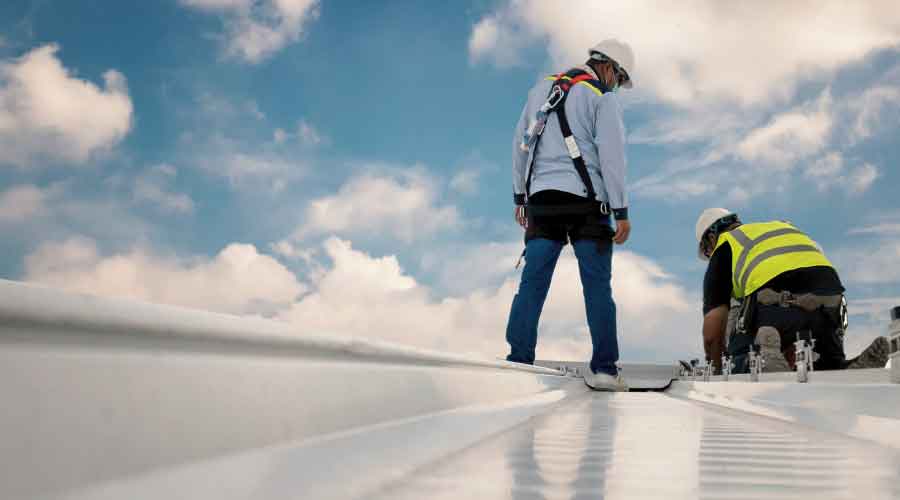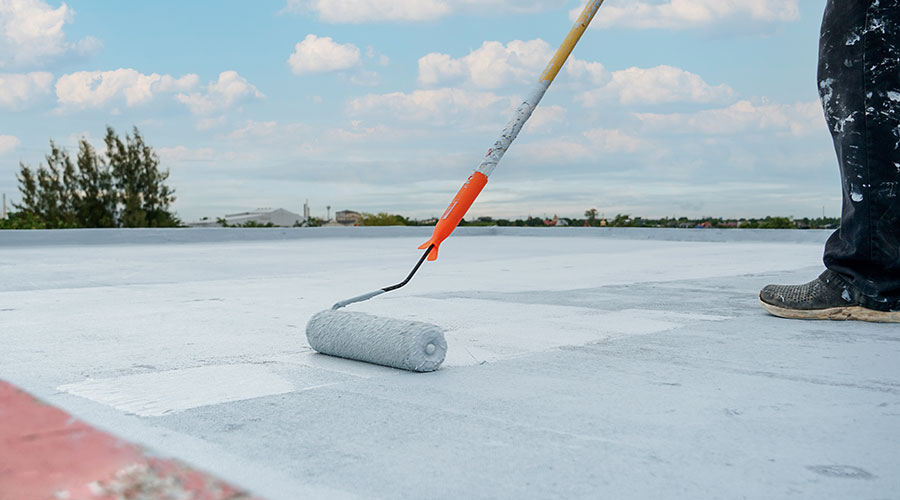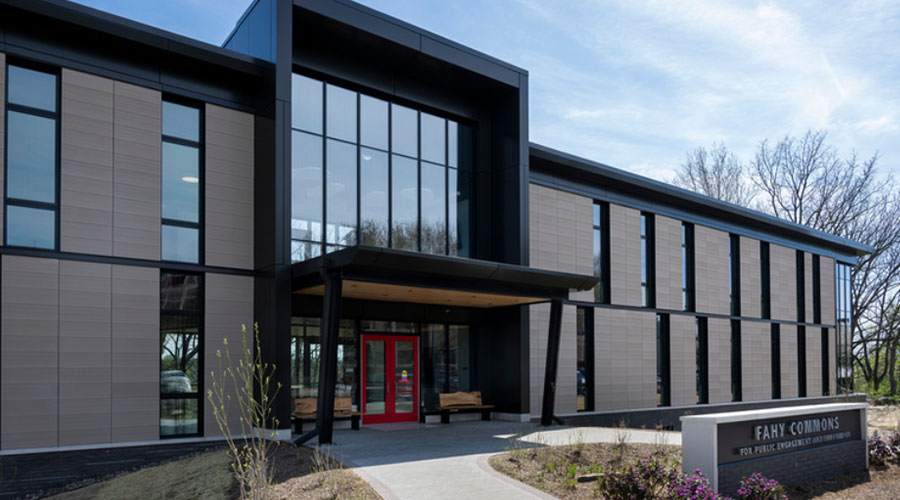How to Spot Troubles in Different Types of Roofs
Common roof problems vary with the type of roof, but several issues are often found in all roof types.
If maintenance and engineering managers are to achieve the long-term performance of their existing roofing systems, it is essential that they implement a comprehensive program that includes regular inspections, required maintenance and timely completed repairs. Depending on their operations, managers can develop a program that uses outside contractors or in-house personnel. Using contractors enables managers to avoid overloading the existing workforce or allowing a heavy workload to interfere with performing roofing tasks. Its downside is cost.
Using in-house personnel to implement the roofing program might cost less, but it also has drawbacks. Besides the risk of having to defer scheduled roofing tasks because of emergencies or higher-priority work, managers must make certain those carrying out the program’s tasks understand the most common roofing trouble spots, ways to identify them and the most effective actions to correct them.
Common trouble spots
The types of problems that occur most often in roofs vary with the type of roof installed, but a number of issues are commonly found in all roof types.
Clogged or restricted roof drains and drainage systems cause water to pond on a roof’s surface. Ponded water has two major negative impacts on the roof. Extended exposure to water can result in the breakdown of some roofing materials. The weight of the water also can compress the roof insulation, resulting in a larger depression in the roof and more water ponding. As a rule of thumb, all water should drain from the roof’s surface within 24 hours.
Installing rooftop equipment also can cause problems for most types of roofs. Technicians must service equipment regularly, resulting in foot traffic concentrated in the area surrounding the equipment. Removing and reinstalling access panels for that equipment also can result in punctures or other damage to the roof membrane. Technicians who service roof-mounted equipment must avoid damaging roof membranes.
Loose flashings, counterflashings and coping can allow water to gain access to the roof under the membrane. Roof inspections must examine all components for proper attachment.
Single-ply spotlight
One of the most common failures in single-ply roofs occurs along the membrane seams. Seam failures typically are the result of improper installation techniques or shrinkage of the membrane as it ages. Failed seams create voids that allow water to gain access under the membrane. During each roof inspection, technicians must carefully examine all seams for integrity.
Blisters that appear in the single-ply membrane are the result of moisture that has gained access under the membrane. Small blisters typically only need to be monitored, but large blisters or those that are expanding are an indication that an active leak is allowing water under the membrane. Repairs require patching or replacing that portion of the membrane and underlying insulation.
If the membrane is not properly attached to the roof, wind can cause it to separate from the roof and partially or fully blow off. It might be possible to reattach a single-ply membrane if the membrane and the underlying roof structure has not been damaged.
Built-up issues
Alligatoring is the most common issue with a built-up roof. With aging and exposure to the sun, the surface of a built-up roof shrinks and develops small cracks. As these cracks grow, the roof surface takes on the appearance of an alligator’s skin. Unless alligatored areas are treated by recoating, these cracks will expand until they extend throughout the membrane. Alligatored areas can be recoated to seal them. Repairing extreme alligatoring requires replacing that portion of the membrane.
Ridges are another common issue with built-up roofs. There are two major causes of ridges in built-up roofs: thermal stress on the roofing membranes and roof insulation that separates from the underlying deck. Left uncorrected, ridges can result in tears in the roofing membrane. Ridge repair requires removing and replacing the membrane and insulation in the damaged area.
As with blisters in single-ply roofs, blisters in the surface of built-up roofs result from moisture that has become trapped under the membrane. They can range in size from 1 inch to several feet in diameter. When they rupture, they allow additional water access into the roofing materials. Repair typically requires cutting out the blistered area membrane and insulation and replacing them.
Modified bitumen problems
Modified bitumen roofs are a hybrid of single-ply and built-up roofs. As such, they tend to share some common defects found in those roof types, including ponding water, blisters and punctures.
Modified bitumen roofs are seamed roofs with sections that are heat-welded together. Thermal expansion and contraction put enough stress on these seams to cause them to fail. If a failure is small, it can be repaired with the reheating of the seam or by applying an adhesive. Larger areas require patching or replacement.
Metal roof Issues
Failure of the roof fasteners is one of the most common issues with metal roofs. Fasteners can fail as a result of corrosion, the use of improper materials and metal fatigue from wind-generated vibrations. Failed fasteners allow panels to be lifted by the wind.
If enough fasteners fail, panels can separate from the roof. During annual roof inspections, technicians must examine all panels for proper attachment and replace damaged or corroded fasteners.
Corrosion is another common issue with metal roofs. Metal roofs typically use steel or aluminum components, both of which are subject to corrosion. Workers can apply protective coatings to the panels and seam materials to limit the impact of corrosion. Any damage to the coating will accelerate the roof’s deterioration.
Making it work
For a roof maintenance program to succeed, managers must ensure that those who perform the inspections, maintenance and repairs must be properly trained, and they must be committed to the program. Equally important, the organization must commit to the program.
That means there must be a dedicated crew whose primary function is carrying out the tasks of the roofing program. Reassigning personnel to other emergencies in the facility will result in deferring roofing maintenance tasks, and deferring these tasks will result in roofing failures, damage to facilities and increased costs.
On-the-job and formal training are essential elements of the program. Technicians must understand the issues and materials they are looking at. For each type of roof installed in the facility, technicians must understand the roofing system design, the way it was installed, the types of defects likely to occur, ways to identify those defects, and the most appropriate repair techniques.
It is not sufficient to assume that just because the crew has been repairing a facility’s roof for years that they are effective. The roofing industry is constantly changing. New materials and products are introduced every year. Products and repair techniques used in the past might no longer be appropriate, and some can even be harmful.
Not only are roofing systems changing, so are the techniques used to identify problems. While visual inspection is still a major part of detecting issues, technicians can use specialized tools to detect issues that are not visible. For example, technicians can use non-contact infrared thermography, electrical capacitance meters, and electric field vector mapping to map areas under the roof membrane that have been damaged by water penetration.
To successfully use these tools, technicians will need training in how to use them and when they are appropriate for a particular application.
Managers have training options to support the roofing program. Roofing manufacturers, training institutes and community colleges offer courses and certificate programs. They are available online and in person.
Roof inspections, maintenance and repair are not one-and-done activities. To succeed, they must be an ongoing effort. Workers must complete inspections at least annually, and they need to perform additional inspections after severe weather or significant activity on the roof. They also must check roofs at least monthly to check for debris, such as leaves or mechanical system components that might have been left by mechanics.
Maintenance activities, such as cleaning drains and gutters, must be regularly scheduled. The frequency of those activities depends on the facility's location and its environment. For example, facilities in a wooded environment will require more frequent maintenance attention.
When technicians identify needed repairs, they need to complete them as quickly as possible. Deferring repairs due to cost or time requirements will only increase long-term costs.
James Piper, P.E., is a national facilities consultant based in Bowie, Md. He has more than 35 years of experience with facilities maintenance, engineering and management issues.
Related Topics:












